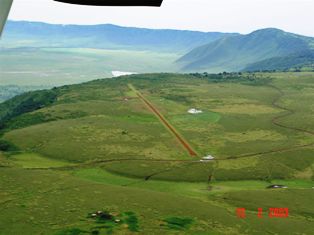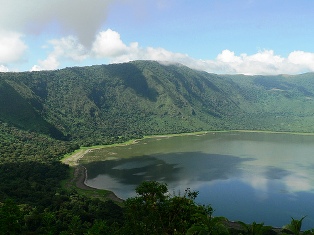Ngorongoro Conservation Area Hotels and Lodges
Do you want information about Ngorongoro Conservation Area Hotels and Safari Lodges, Campsites, Wildlife? Here is the page for you.
Welcome to Ngorongoro Conservation in Tanzania the Craddle of Mankind in Africa.
The Ngorongoro Conservation Area is both a fantastic game-viewing destination and a significant archaeological treasure.
Often called an 'African Eden' and the 'Eighth Wonder of the Natural World'.
The terrain embraces several distinct habitats from open grasslands to mountain forest, and from scrub bushland to highland heath.
Around 25,000 animals live in the Ngorongoro Crater thoughout the year, whilst in the NCA, as a whole, the numbers can swell to more than 2.5 million, depending on the season.
List of Luxury Safari Hotels in Ngorongoro Tanzania
andBeyond Ngorongoro Crater Lodge › |
Ngorongoro Wildlife Lodge › |
Highview Hotel › |
Special Accommodation Facilities in Ngorongoro Tanzania
The Manor at Ngorongoro › |
Exploreans Ngorongoro Lodge › |
Kisima Ngeda Tented Camp › |
Masek Tented Camp › |
Ngorongoro Forest Tented Lodge › |
Tloma Mountain Lodge › |
Lemala Ngorongoro › |
Ngorongoro Farm House › |
Ngorongoro Serena Safari Lodge › |
Kuhama Camp › |
Mysigio Camp › |
Ngorongoro Rhino Lodge › |
Lemala Ndutu › |
The Octagon Safari Lodge › |
Crater Forest Tented Lodge › |
Kensington Endoro › |
Crater Forest Tented Camp › |
Ngorongoro Serena Lodge › |
Ngulia Wildlife Lodge › |
Ngorongoro Wildlife Lodge › |
Ngorongoro Crater Lodge › |
Gibbs Farm › |
Ngorongoro Farm house Lodge › |
Lobo Wildlife Lodge › |
More Information about Ngorongoro Conservation Area
It is also a pioneering experiment in multiple land use. For Ngorongoro Conservation Area, the idea of multiple land use means to allow humans and Wildlife to co-exist in natural setting.
The relationship between the Maasai tribe and the Ngorongoro eco-system is impressive.
The Maasai herd their cattle into and out of the crater daily for water, leading their cattle to water alongside the "Big 5".
However, the Ngorongoro crater is just a small part of the Ngorongoro Conservation Area.
It is a huge caldera (collapsed volcano) 300 square km in size, 19.2 km in diameter and 600 meters deep.
It is home to one of the world's largest inactive and unflooded volcanic calderas with a rich diversity of Tanzania wildlife safari(including some of Tanzania's last remaining black rhino), and the famous paleontological site of Oldovai Gorge nearby.
Other Related Attractions in Tanzania
Tanzania Destinations › | Mkoma Bay › | Saadani Beaches › | Ndutu Conservation › | Ngorongoro Conservation › | Ngorongoro Crater › | Njombe › | Mafia Island Beaches › | Mafia Island › | Tanzania Attractions › | Tanzania Beaches › | Oldvai gorge › | Pangani Beaches › | Pemba Island Beaches › | Places to Visit in Tanzania › |Location:
4 hours drive from Arusha on the way to the Serengeti (Serengeti National Park).
Things to Do:
Game-Drives, Hiking, Nature Walk, Visit a Maasai Boma, Visit Oldovai Gorge.
Time to visit:
1 half-day is usually enough to see the Ngorongoro Crater (Ngorongoro Wildlife Safaris), not more than 2 half- days.
Animals:
One of the few places you have a chance to spot rhinos. The Ngorongoro Crater support a large resident population of wildlife pre-dominantly grazing animals.
These include Wildebeest, Buffalo, Zebra, Giraffe, Gazelle, Eland, and Warthog. The swamps and forests provide additional resources for Hippo, Elephant, Waterbuck, Reedbuck and Bushbuck, Baboons and vervet monkeys.
Jackals thrive in the Ngorongoro Crater and bat-eared foxes live in the short grass. Predatory animals: Lion, Leopard and Cheetah, several cats and large packs of Hyena roam the Ngorongoro Crater, making their own kills and scavenging from others.
More than 100 species of birds not found in the Serengeti (Serengeti National Park) have been spotted here.
Countless Flamingos form a pink blanket over the soda lakes. Distinctive grassland birds- Ostrich, Koribustareds and Crowned Crains seen in abandances.

Oldovai Gorge
Olduvai Gorge is known as the cradle of mankind. Layer upon layer of volcanic deposits were laid down in orderly sequence over a period of almost two million years, making Olduvai Gorge a remarkable site that documents ancient life.
It is here that Louis and Mary Leakey discovered the first human skull of Zinjanthropus, commonly known as 'Nutcracker Man' after nearly 30 years of excavation.
Now renamed Australopithecus boisei, this creature had a massive skull with huge teeth that suggested a diet of coarse vegetable food, and lived 1.75 million years ago.
Nearby are the Laetoli footprints of walking adult and young aged 3 million years. The remains of pre-historic Elephants, giant-horned Sheep and enormous ostriches have been unearthed here.
Location:
Olduvai Gorge is conveniently located between Ngorongoro Wildlife Safaris- Ngorongoro Crater and the Serengeti National Park. Although there is an unimpressive museum with a lot of information, it is usually worth a quick stop even for those who are only slightly interested in history and/or archeology.
Activity Duration:
1-2 hours
Ol Doinyo Lengai:
Ol Doinyo Lengai is also known as the "Mountain of God" by the Maasai. They believe that the mountain increases fertility and they advise women who have difficulty conceiving to visit.
The trek up to the Ngorongoro Wildlife Safaris (Ngorongoro Crater) is an exceptionally demanding climb of around 1700m (5600 ft).
The trek starts at midnight or shortly after so you can walk during the cool hours and reach the summit by dawn.
This is the only active volcano in the area and the world's only natrocarbonate volcano, having erupted in 1966 and 1983.
The most recent erruption occured around July 2007 - 2008. It's a truly unusual destination for those who really want to get off the beaten path.
Location:
It is located just outside the NCA, to the north-east near Lake Natron.
Recent Articles
-
Garam Masala Appetizers ,How to Make Garam Masala,Kenya Cuisines
Sep 21, 14 03:38 PM
Garam Masala Appetizers are originally Indian food but of recent, many Kenyans use it. Therefore, on this site, we will guide you on how to make it easily. -
The Details of the Baruuli-Banyara People and their Culture in Uganda
Sep 03, 14 12:32 AM
The Baruuli-Banyala are a people of Central Uganda who generally live near the Nile River-Lake Kyoga basin. -
Guide to Nubi People and their Culture in Kenya and Uganda
Sep 03, 14 12:24 AM
The Nubians consist of seven non-Arab Muslim tribes which originated in the Nubia region, an area between Aswan in southern








New! Comments
Have your say about what you just read! Leave me a comment in the box below.